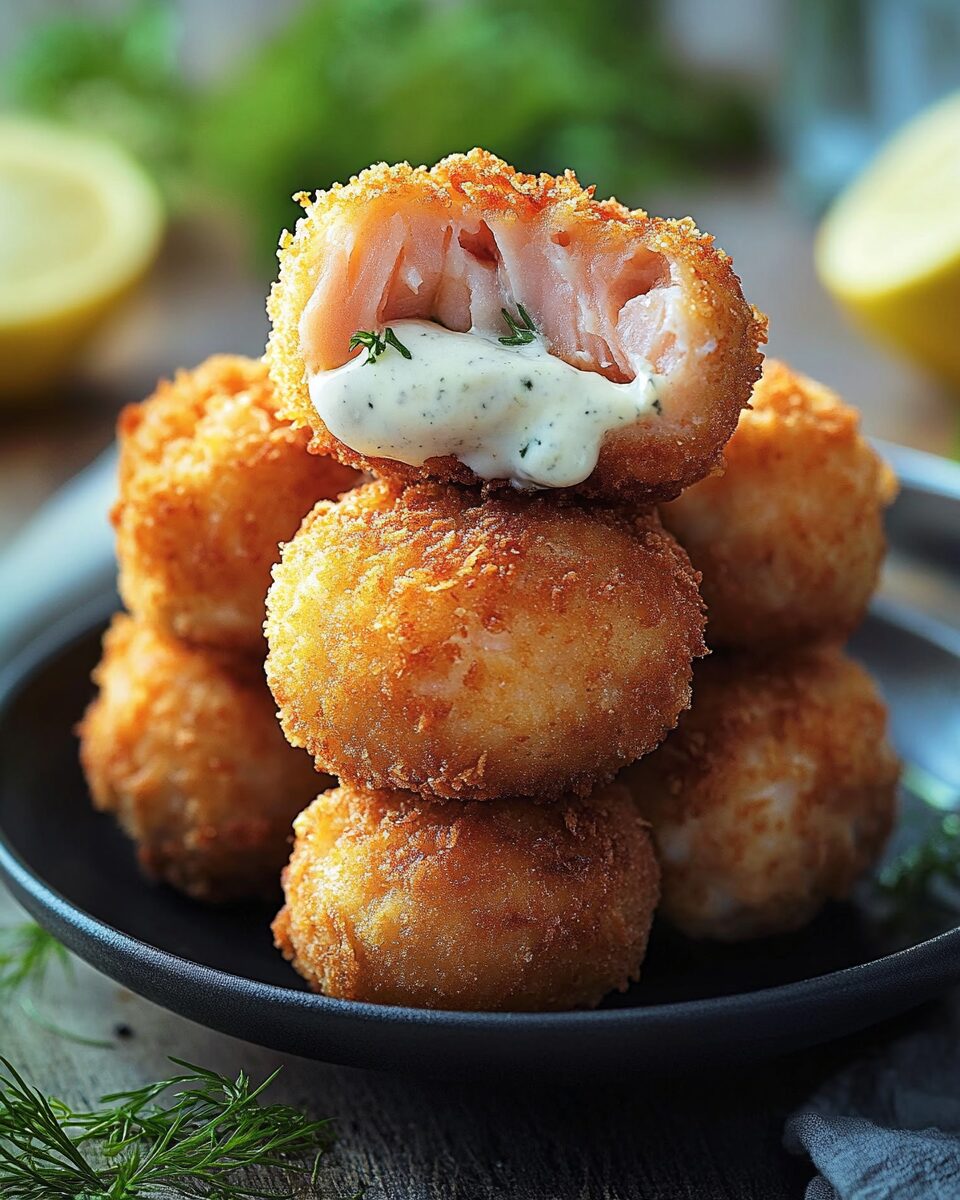These crispy salmon croquettes are the perfect blend of flaky salmon, crunchy Panko, and vibrant bell peppers. The fresh cilantro adds a burst of herbaceous flavor that complements the richness of the salmon. Whether served as an appetizer or a light meal, these croquettes deliver a satisfying bite every time.
Perfectly crispy on the outside and tender on the inside, these croquettes are easy to prepare and versatile enough to be paired with your favorite dipping sauces. Ideal for a quick weeknight dinner or as a crowd-pleasing party snack, they are sure to be a hit at any table.
Full Recipe:
- 16 oz fresh or canned salmon, flaked
- 1 large egg, lightly beaten
- ½ cup Panko breadcrumbs
- ¼ cup all-purpose flour
- ½ green bell pepper, chopped
- ½ red bell pepper, chopped
- ¼ cup mayonnaise
- 1 tablespoon Worcestershire sauce
- ¼ cup chopped cilantro
- ½ teaspoon garlic powder
- ½ teaspoon salt
- ¼ teaspoon black pepper
- Avocado oil (for frying)
Directions:
- Prep the Salmon: If using fresh salmon, ensure it is fully cooked and cooled, then flake it with two forks. For canned salmon, drain thoroughly, remove any skin or bones, and flake gently.
- Mix Dry Ingredients: In a bowl, whisk together the Panko breadcrumbs, flour, garlic powder, salt, and pepper.
- Combine Wet Ingredients: In a separate bowl, mix the flaked salmon, mayonnaise, Worcestershire sauce, chopped bell peppers, cilantro, and the beaten egg.
- Integrate Mixtures: Gently fold the wet ingredients into the dry ingredients until just combined. If the mixture is too wet, add more breadcrumbs gradually.
- Form Patties: Wet your hands lightly to avoid sticking. Form the mixture into small croquette patties.
- Fry the Croquettes: Heat avocado oil in a skillet over medium heat. Once hot (about 350°F), fry the croquettes for 2-3 minutes on each side, or until golden brown.
- Serve and Enjoy: Drain on paper towels, serve hot with your favorite dipping sauce.
Prep Time: 15 minutes | Cooking Time: 10 minutes | Total Time: 25 minutes
Kcal: 242 kcal | Servings: 6 croquettes
Nutritional Benefits
Salmon croquettes are not only delicious but also packed with essential nutrients. Salmon is an excellent source of high-quality protein, which is vital for muscle repair and growth. It’s rich in omega-3 fatty acids, which are known to support heart health, reduce inflammation, and improve brain function. Additionally, the inclusion of bell peppers adds a boost of vitamins A and C, antioxidants that help protect your cells from damage. Using whole grain breadcrumbs can increase the fiber content, aiding in digestion and promoting a feeling of fullness.
Cooking Tips
- Choosing the Right Salmon: Fresh salmon provides the best flavor and texture, but canned salmon can be a convenient and equally tasty alternative. Ensure that canned salmon is thoroughly drained to prevent the mixture from becoming too wet.
- Binding the Mixture: If the croquette mixture feels too loose, add a bit more breadcrumbs or a tablespoon of flour to help bind the ingredients together.
- Frying Temperature: Maintaining the oil temperature around 350°F (175°C) is crucial for achieving a crispy exterior without overcooking the inside. Use a kitchen thermometer to monitor the oil temperature accurately.
- Avoid Overmixing: Gently fold the ingredients to keep the croquettes light and airy. Overmixing can lead to dense and heavy croquettes.
Variations
- Spicy Kick: Add finely chopped jalapeños or a dash of cayenne pepper to the mixture for a spicy twist.
- Cheesy Delight: Incorporate shredded cheese like cheddar or Parmesan into the croquette mixture for an extra layer of flavor.
- Herb Infusion: Experiment with different herbs such as dill, parsley, or thyme to customize the flavor profile to your liking.
- Vegan Option: Replace salmon with mashed chickpeas or lentils and use plant-based mayonnaise to create a vegan-friendly version of the croquettes.
Serving Suggestions
- Dipping Sauces: Serve the croquettes with a variety of dipping sauces such as tartar sauce, garlic aioli, or a tangy lemon-dill yogurt sauce.
- Side Dishes: Pair the salmon croquettes with a fresh green salad, steamed vegetables, or roasted potatoes for a complete meal.
- Appetizer Platter: Arrange the croquettes on a platter with lemon wedges, pickles, and olives for an impressive appetizer spread at gatherings or parties.
Storage and Reheating
- Storing Leftovers: Allow the croquettes to cool completely before storing them in an airtight container in the refrigerator for up to 3 days.
- Freezing: To freeze, place the uncooked croquettes on a baking sheet lined with parchment paper and freeze until solid. Transfer them to a freezer-safe bag or container and store for up to 2 months. Reheat in the oven or air fryer directly from frozen.
- Reheating Tips: For the best texture, reheat the croquettes in a preheated oven at 350°F (175°C) for about 10 minutes or until heated through and crispy.
Health Considerations
While salmon croquettes are a healthy option, it’s important to be mindful of the cooking oil used. Opt for heart-healthy oils like avocado oil or olive oil for frying. Additionally, controlling portion sizes can help manage calorie intake, especially if serving as part of a larger meal.
Pairing Suggestions
- Beverages: A crisp white wine such as Sauvignon Blanc or a light beer like pilsner pairs wonderfully with salmon croquettes. For non-alcoholic options, consider a sparkling water with a slice of lemon or a refreshing iced tea.
- Complementary Dishes: Serve alongside creamy coleslaw, garlic mashed potatoes, or a quinoa salad to create a balanced and satisfying meal.
Cultural Context
Salmon croquettes draw inspiration from various culinary traditions, blending the rich flavors of seafood with the comforting texture of croquettes. This versatile dish is popular in many coastal regions, where fresh salmon is abundant. Its adaptability allows it to fit seamlessly into both casual family dinners and elegant gatherings.
Ingredient Sourcing Tips
- Salmon: Opt for wild-caught salmon for a richer flavor and higher omega-3 content. If unavailable, sustainably sourced farmed salmon is a good alternative.
- Bell Peppers: Choose fresh, firm bell peppers with vibrant colors for the best flavor and presentation.
- Cilantro: Look for bright green cilantro with no yellowing or wilting leaves to ensure freshness.
- Breadcrumbs: For a gluten-free version, check the label to ensure the breadcrumbs are certified gluten-free.
Chef’s Notes
- Enhancing Flavor: To deepen the flavor of your croquettes, consider adding a splash of lemon juice or a teaspoon of Dijon mustard to the mixture.
- Texture Tips: Ensure the croquette mixture is not too wet to maintain a crispy exterior. If necessary, add more breadcrumbs or allow the mixture to rest in the refrigerator for 30 minutes before shaping.
- Presentation: For an elegant presentation, garnish the croquettes with a sprinkle of fresh herbs and serve them alongside a wedge of lemon or a colorful dipping sauce.
Presentation Tips
- Plating: Arrange the croquettes in a neat row or fan them out on a large platter. Add a garnish of fresh herbs, such as parsley or cilantro, and include lemon wedges for a pop of color.
- Dipping Sauces: Serve with a variety of dipping sauces like tartar sauce, aioli, or a zesty yogurt-based dip to enhance the flavors.
- Accompaniments: Pair the croquettes with a fresh green salad, roasted vegetables, or a light quinoa salad to create a balanced and visually appealing meal.
Ingredient Substitutes
- Mayonnaise: For a lighter version, use Greek yogurt or a plant-based mayonnaise alternative.
- Worcestershire Sauce: Tamari or soy sauce can be used as a substitute, especially for a gluten-free option.
- Panko Breadcrumbs: If panko is unavailable, use regular breadcrumbs or crushed cornflakes for added crunch.
Historical Background and Inspiration
Croquettes have a rich history rooted in European cuisine, particularly French and Spanish traditions. Originally, croquettes were a way to repurpose leftover ingredients, blending them with a binding agent and coating them for frying. The concept has since evolved, embracing various cultural influences and ingredients. Salmon croquettes, in particular, draw inspiration from coastal culinary practices where fresh seafood is abundant. This fusion of traditional croquette techniques with the flavors of the sea results in a dish that is both nostalgic and innovative.
Common Mistakes and How to Avoid Them
- Overmixing the Mixture: Overmixing can lead to dense and heavy croquettes. Gently fold the ingredients until just combined to maintain a light texture.
- Incorrect Oil Temperature: Frying at too low a temperature can make the croquettes greasy, while too high a temperature may burn the exterior before the interior is cooked. Use a kitchen thermometer to maintain the oil at around 350°F (175°C).
- Inadequate Binding: If the mixture is too loose, the croquettes may fall apart during cooking. Ensure the right balance of wet and dry ingredients, and add more breadcrumbs if necessary.
- Not Draining Properly: Excess moisture can prevent the croquettes from crisping up. Ensure that the salmon is well-drained and avoid adding too much mayonnaise.
Dietary Modifications
- Low-Carb: Replace breadcrumbs with almond flour or crushed pork rinds to reduce the carbohydrate content.
- Vegan: Substitute salmon with mashed chickpeas or lentils, use plant-based mayonnaise, and ensure all other ingredients are vegan-friendly.
- Low-Sodium: Reduce the amount of salt and use low-sodium Worcestershire sauce or tamari to make the recipe more suitable for those monitoring their sodium intake.
- Gluten-Free: Use gluten-free breadcrumbs or alternative coatings to make the croquettes suitable for a gluten-free diet.
How to Make It Ahead of Time
- Preparation: You can prepare the croquette mixture up to 24 hours in advance. Store it in an airtight container in the refrigerator until ready to shape and cook.
- Shaping and Storing: Shape the croquettes and place them on a baking sheet lined with parchment paper. Freeze them until solid, then transfer to a freezer-safe bag or container. Cook directly from frozen, adding a few extra minutes to the cooking time.
Serving Suggestions
- Brunch Option: Serve the salmon croquettes alongside scrambled eggs, avocado slices, and a fresh fruit salad for a hearty brunch.
- Gourmet Presentation: Top the croquettes with a dollop of crème fraîche, a sprinkle of chives, and a drizzle of truffle oil for an upscale appetizer.
- Casual Gathering: Include the croquettes in a tapas-style spread with a variety of small bites, such as olives, cheeses, and marinated vegetables.
Pairing Suggestions
- Beverages: A crisp white wine like Pinot Grigio or a light rosé complements the rich flavors of the salmon. For non-alcoholic options, consider a citrus-infused sparkling water or a herbal iced tea.
- Complementary Dishes: Serve with creamy coleslaw, roasted asparagus, or a tangy quinoa salad to balance the meal with different textures and flavors.
Environmental Impact and Sustainability
Choosing sustainably sourced salmon helps reduce the environmental impact associated with overfishing and habitat destruction. Look for certifications such as MSC (Marine Stewardship Council) or ASC (Aquaculture Stewardship Council) to ensure your seafood is responsibly harvested. Additionally, minimizing food waste by using leftover ingredients creatively in recipes like croquettes contributes to a more sustainable kitchen practice.
Chef’s Tips for Perfect Croquettes
- Consistency is Key: Ensure the salmon is flaked finely to achieve a uniform texture throughout the croquette.
- Chill Before Cooking: Refrigerating the shaped croquettes for 30 minutes before frying or baking helps them hold their shape better during cooking.
- Even Cooking: Make sure the croquettes are of uniform size to ensure they cook evenly. Using a small ice cream scoop can help achieve consistent sizes.
Conclusion
Salmon croquettes are a versatile and delicious addition to any meal, offering a delightful combination of flavors and textures. Whether you’re preparing a quick weeknight dinner or an impressive appetizer for guests, this recipe is sure to satisfy. With various customization options and dietary adaptations, it’s a dish that can be tailored to suit any palate or occasion.






